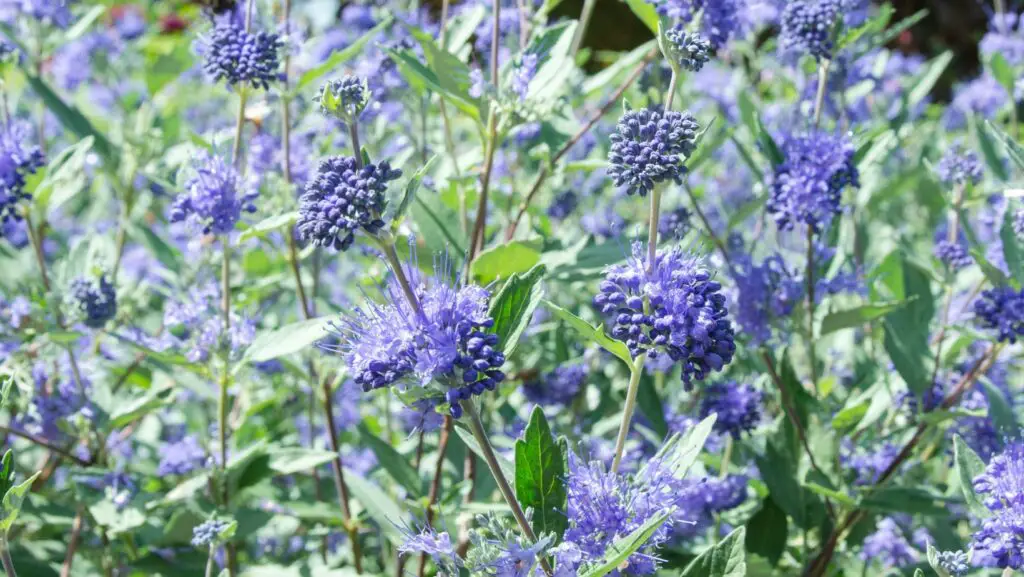
The caryopteris is a bit of an inconspicuous plant. Nevertheless, it would be a shame to do without it in temperate climates, as blue summer flowering shrubs are few and far between. Some recent improvements give it a welcome extra liveliness.
In this article, I have gathered for you all the information about this plant, its main characteristics and what you need to know to plant and grow it.
Characteristics of the caryopteris clandonensis
| Scientific name | Caryopteris x clandonensis |
| Family | Verbenaceae |
| Origin | East Asia |
| Foliage | Deciduous |
| Flowering | June-September |
| Rusticity | -8°C to -10°C (-46°F to -50°F) |
| Exposure | Sun |
| Soil | Indifferent |
The caryopteris is a shrub of rounded form (it’s a small bush: height 1 m, diameter 60 cm), carrying many small branches, erect to spread. Its finely toothed, bluish-green, slightly silvery and aromatic leaves are soft and gentle to the touch. The intense blue flowers are grouped in small terminal bouquets.
How to grow a caryopteris plant
The caryopteris is not very demanding on the nature of the soil, but a fertile ground ensures him a growth and a vigour largely superior. Make sure the soil is well drained, as it does not like excess water. On the other hand, do not neglect watering in summer and keep the soil fresh.
Reserve for this shrub a sunny and warm exposure sheltered from strong winds, for example in a corner or at the foot of a wall.
It has no known pests or diseases.
Tip: In the garden or in a pot, prune the caryopteris short to leave only 30 cm of vegetation, if possible at the end of the flowering.
How to grow a caryopteris shrub in a pot
You will have to be a little patient: the first two years, the caryopteris lacks exuberance when cultivated in a pot. But as it reacts well to severe pruning, reduce its vegetation by half in spring – even late, even if it means skipping the flowering.
By the third year, it will be quite bushy and will be able to stay in its pot for several years thanks to regular fertilization (fertilizer for flowering shrubs every month from March to September).
Plan from the start a large pot of 50 cm in diameter. Remember to put a drainage layer at the bottom of the pot (gravel, clay balls) and use a potting soil enriched with seaweed muck.
You can save time by buying a plant already formed, in a 7 to 10 liter container.
Tip: Reveal the blue of the caryopteris by daring to associate it with bright tones. Plant summer flowering annuals – nasturtiums, petunias, surfinias, bidens and pelargoniums -, especially in planters, to give it extra consistency.
Where to plant a caryopteris clandonensis
It is best planted in a bed, either as a single specimen or grouped together with other shrubs to create a border or low hedge. It also looks great in a pot, where it can be easily moved around the garden to create a different look or choose a spot with the best light.
When planting in a bed, it is important to ensure that the soil is well drained, as this will help the shrub to thrive. Additionally, it is important to water the shrub regularly and to prune it back in late winter or early spring to encourage new growth.
Combine it with other silver foliage shrubs to create a cameo: teucrium, perovskia or santolin in mild climates.
Our selection
Caryopteris × clandonensis is at the base of some improvements, of which ‘Heavenly Blue‘ which dethrones it little by little. It has a rather erect habit, a more vigorous vegetation, larger flowers with a strong purplish hue.
- ‘Kew Blue‘ also shows an intense color and a strong foliage.
- ‘Big Blue‘ is characterized by a dense vegetation and a globular, stocky form, particularly interesting for pot culture. In this job, also look for ‘First Choice‘, for its compact habit.
- Placed in full sun, ‘Worcester Gold‘ has a beautiful golden yellow color to its foliage. Pair it with the above varieties.
In a nutshell
The Caryopteris Clandonensis is a special and beautiful shrub that can make for an excellent addition to any garden. It will bring a unique sense of softness and elegance to any landscape. With its attractive coloration and foliage, it is sure to draw in visitors all throughout the year. Whether you plant it as a border or add it as part of your flower bed, this shrub is sure to bring a sense of peace and tranquillity to its environment.

Hi!
I am the guy behind Theyardable.com. I grew up on a homestead and I am here to share the knowledge I have and things I learn while living in the countryside.
